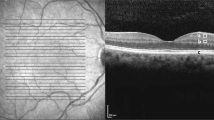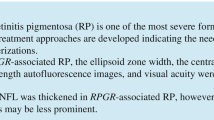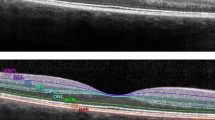Abstract
Background
Peripapillary retinal nerve fiber layer thickness correlates with radiological and clinical parameters in patients with MS.
Objective
The aim of this study is to investigate the use of the first measured pRNFL thickness as a predictor of disease course in patients with RRMS.
Methods
One hundred and thirty seven RRMS patients were enrolled in the study within the first 5 years of illness. Patients were followed for 34.1 months and the EDSS was used to assess disability status to determine whether the first measured pRNFL thickness, using proportional hazards models, predicts the risk of disability worsening.
Results
The mean disease duration was 26.1 months. Disability worsening was detected in 36 patients. In tertile-based groups formed according to pRNFL thickness, the group with the lowest pRNFL thickness had a 2.8-fold increase in the risk of disability worsening compared to the group with the highest. The risk was higher in the first 2 years of the study (HR = 3.48; p = 0.008).
Conclusion
The first measured pRNFL thickness in RRMS patients can predict the risk of disability worsening, and the risk of disability worsening in the early period was higher in the group with the lowest pRNFL value.


Similar content being viewed by others
Availability of data and materials
The dataset used and analyzed during the current study is available from the corresponding author on reasonable request.
References
Balk LJ, Cruz-Herranz A, Albrecht P, Arnow S, Gelfand JM, Tewarie P, Killestein J, Uitdehaag BMJ, Petzold A, Green AJ (2016) Timing of retinal neuronal and axonal loss in MS: a longitudinal OCT study. J Neurol 263:1323–1331
Bsteh G, Hegen H, Teuchner B, Amprosi M, Berek K, Ladstätter F, Wurth S, Auer M, Di Pauli F, Deisenhammer F, Berger T (2019) Peripapillary retinal nerve fibre layer as measured by optical coherence tomography is a prognostic biomarker not only for physical but also for cognitive disability progression in multiple sclerosis. Mult Scler 25:196–203
Cilingir V, Batur M (2020) Axonal degeneration independent of inflammatory activity: is it more intense in the early stages of relapsing-remitting multiple sclerosis disease? Eur Neurol 83:508–516
Cilingir V, Batur M, Bulut MD, Milanlioglu A, Yilgor A, Batur A, Yasar T, Tombul T (2017) The association between retinal nerve fibre layer thickness and corpus callosum index in different clinical subtypes of multiple sclerosis. Neurol Sci 38:1223–1232
Costello F, Hodge W, Pan YI, Freedman M, DeMeulemeester C (2009) Differences in retinal nerve fiber layer atrophy between multiple sclerosis subtypes. J Neurol Sci 281:74–79
Davion JB, Lopes R, Drumez É, Labreuche J, Hadhoum N, Lannoy J, Vermersch P, Pruvo JP, Leclerc X, Zéphir H, Outteryck O (2020) Asymptomatic optic nerve lesions: an underestimated cause of silent retinal atrophy in MS. Neurology 94:e2468–e2478
Freedman MS, Abdoli M (2015) Evaluating response to disease-modifying therapy in relapsing multiple sclerosis. Expert Rev Neurother 15:407–423
Gabilondo I, Martínez-Lapiscina EH, Martínez-Heras E, Fraga-Pumar E, Llufriu S, Ortiz S, Bullich S, Sepulveda M, Falcon C, Berenguer J, Saiz A, Sanchez-Dalmau B, Villoslada P (2014) Trans-synaptic axonal degeneration in the visual pathway in multiple sclerosis. Ann Neurol 75:98–107
Garcia-Martin E, Ara JR, Martin J, Almarcegui C, Dolz I, Vilades E, Gil-Arribas L, Fernandez FJ, Polo V, Larrosa JM, Pablo LE, Satue M (2017) Retinal and optic nerve degeneration in patients with multiple sclerosis followed up for 5 years. Ophthalmology 124:688–696
Gil-Perotin S, Castillo-Villalba J, Cubas-Nuñez L, Gasque R, Hervas D, Gomez-Mateu J, Alcala C, Perez-Miralles F, Gascon F, Dominguez JA, Casanova B (2019) Combined cerebrospinal fluid neurofilament light chain protein and chitinase-3 like-1 levels in defining disease course and prognosis in multiple sclerosis. Front Neurol 10:1008
Havas J, Leray E, Rollot F, Casey R, Michel L, Lejeune F, Wiertlewski S, Laplaud D, Foucher Y (2020) Predictive medicine in multiple sclerosis: a systematic review. Mult Scler Relat Disord 40:101928
Kalincik T, Manouchehrinia A, Sobisek L, Jokubaitis V, Spelman T, Horakova D, Havrdova E, Trojano M, Izquierdo G, Lugaresi A, Girard M, Prat A, Duquette P, Grammond P, Sola P, Hupperts R, Grand’Maison F, Pucci E, Boz C, Alroughani R, Van Pesch V, Lechner-Scott J, Terzi M, Bergamaschi R, Iuliano G, Granella F, Spitaleri D, Shaygannejad V, Oreja-Guevara C, Slee M, Ampapa R, Verheul F, McCombe P, Olascoaga J, Amato MP, Vucic S, Hodgkinson S, Ramo-Tello C, Flechter S, Cristiano E, Rozsa C, Moore F, Luis Sanchez-Menoyo J, Laura Saladino M, Barnett M, Hillert J, Butzkueven H (2017) Towards personalized therapy for multiple sclerosis: prediction of individual treatment response. Brain 140:2426–2443
Lange AP, Zhu F, Sayao A-L, Sadjadi R, Alkabie S, Traboulsee AL, Costello F, Tremlett H (2013) Retinal nerve fiber layer thickness in benign multiple sclerosis. Mult Scler 19:1275–1281
Lassmann H (2018) Multiple sclerosis pathology. Cold Spring Harb Perspect Med 8:a028936
Martinez-Lapiscina EH, Arnow S, Wilson JA, Saidha S, Preiningerova JL, Oberwahrenbrock T, Brandt AU, Pablo LE, Guerrieri S, Gonzalez I, Outteryck O, Mueller AK, Albrecht P, Chan W, Lukas S, Balk LJ, Fraser C, Frederiksen JL, Resto J, Frohman T, Cordano C, Zubizarreta I, Andorra M, Sanchez-Dalmau B, Saiz A, Bermel R, Klistorner A, Petzold A, Schippling S, Costello F, Aktas O, Vermersch P, Oreja-Guevara C, Comi G, Leocani L, Garcia-Martin E, Paul F, Havrdova E, Frohman E, Balcer LJ, Green AJ, Calabresi PA, Villoslada P (2016) Retinal thickness measured with optical coherence tomography and risk of disability worsening in multiple sclerosis: a cohort study. Lancet Neurol 15:574–584
Nolan RC, Galetta SL, Frohman TC, Frohman EM, Calabresi PA, Castrillo-Viguera C, Cadavid D, Balcer LJ (2018) Optimal intereye difference thresholds in retinal nerve fiber layer thickness for predicting a unilateral optic nerve lesion in multiple sclerosis. J Neuroophthalmol 38:451–458
Oberwahrenbrock T, Ringelstein M, Jentschke S, Deuschle K, Klumbies K, Bellmann-Strobl J, Harmel J, Ruprecht K, Schippling S, Hartung H-P, Aktas O, Brandt AU, Paul F (2013) Retinal ganglion cell and inner plexiform layer thinning in clinically isolated syndrome. Mult Scler 19:1887–1895
Pellegrini F, Copetti M, Bovis F, Cheng D, Hyde R, de Moor C, Kieseier BC, Sormani MP (2020) A proof-of-concept application of a novel scoring approach for personalized medicine in multiple sclerosis. Mult Scler 26:1064–1073
Petzold A, Balcer LJ, Calabresi PA, Costello F, Frohman TC, Frohman EM, Martinez-Lapiscina EH, Green AJ, Kardon R, Outteryck O, Paul F, Schippling S, Vermersch P, Villoslada P, Balk LJ, Ern-Eye I (2017) Retinal layer segmentation in multiple sclerosis: a systematic review and meta-analysis. Lancet Neurol 16:797–812
Saidha S, Al-Louzi O, Ratchford JN, Bhargava P, Oh J, Newsome SD, Prince JL, Pham D, Roy S, van Zijl P, Balcer LJ, Frohman EM, Reich DS, Crainiceanu C, Calabresi PA (2015) Optical coherence tomography reflects brain atrophy in multiple sclerosis: a four-year study. Ann Neurol 78:801–813
Saidha S, Syc SB, Ibrahim MA, Eckstein C, Warner CV, Farrell SK, Oakley JD, Durbin MK, Meyer SA, Balcer LJ, Frohman EM, Rosenzweig JM, Newsome SD, Ratchford JN, Nguyen QD, Calabresi PA (2011) Primary retinal pathology in multiple sclerosis as detected by optical coherence tomography. Brain 134:518–533
Sormani MP, Rio J, Tintorè M, Signori A, Li D, Cornelisse P, Stubinski B, Stromillo M, Montalban X, De Stefano N (2013) Scoring treatment response in patients with relapsing multiple sclerosis. Mult Scler 19:605–612
Tewarie P, Balk L, Costello F, Green A, Martin R, Schippling S, Petzold A (2012) The OSCAR-IB consensus criteria for retinal OCT quality assessment. PLoS ONE 7:e34823
Tintore M, Rovira À, Río J, Otero-Romero S, Arrambide G, Tur C, Comabella M, Nos C, Arévalo MJ, Negrotto L, Galán I, Vidal-Jordana A, Castilló J, Palavra F, Simon E, Mitjana R, Auger C, Sastre-Garriga J, Montalban X (2015) Defining high, medium and low impact prognostic factors for developing multiple sclerosis. Brain 138:1863–1874
Acknowledgments
The authors want to explicitly thank Demet Kırk who diligently performed OCT scans for this study.
Funding
This research received no specific grant from any funding agency in the public, commercial, or not-for-profit sectors.
Author information
Authors and Affiliations
Corresponding author
Ethics declarations
Statement of ethics
The authors assert that all procedures contributing to this work comply with the ethical standards of the relevant national and institutional committees on human experimentation and with the Helsinki Declaration of 1975, as revised in 2008. All the subjects provided their written informed consent, and the study protocol was accepted by the local ethics committee of our university.
Conflicts of interest
The authors declare that there is no conflict of interest.
Rights and permissions
About this article
Cite this article
Cilingir, V., Batur, M. First measured retinal nerve fiber layer thickness in RRMS can be used as a biomarker for the course of the disease: threshold value discussions. J Neurol 268, 2858–2865 (2021). https://doi.org/10.1007/s00415-021-10469-x
Received:
Revised:
Accepted:
Published:
Issue Date:
DOI: https://doi.org/10.1007/s00415-021-10469-x




